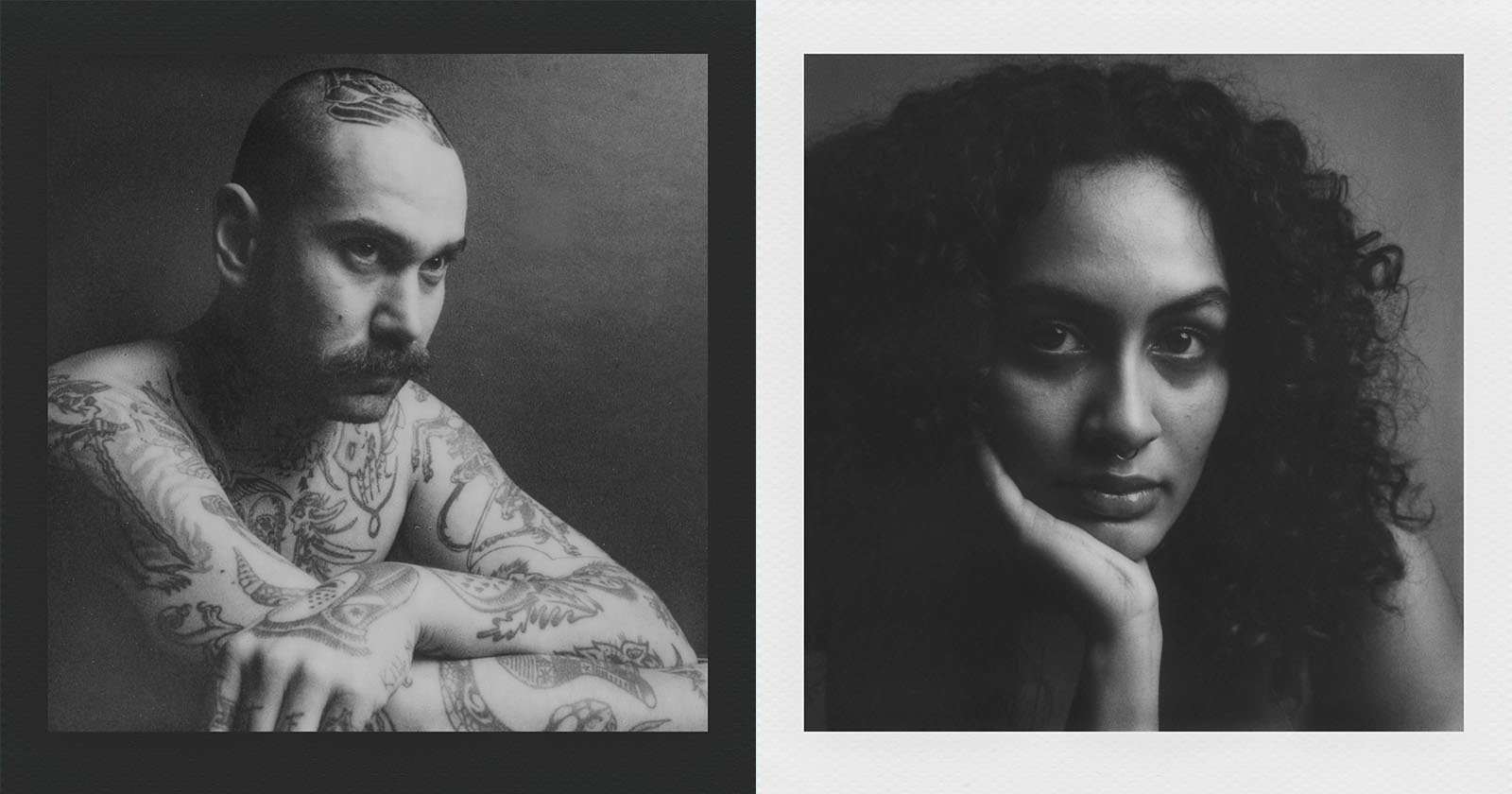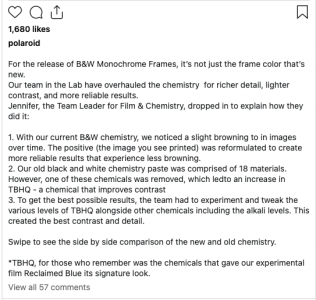Mackinaw
Think Different
For those who shoot with a Polaroid, they just introduced an improved B&W 600-series film. They're calling it a significant upgrade with improved clarity and lighter contrast.

 petapixel.com
petapixel.com
Jim B.
Polaroid Unveils Improved Chemistry for B&W 600 Instant Film
Polaroid is back in black (and white).
Jim B.
agentlossing
Well-known
The examples (Polaroid's own) in the article still look wildly inconsistent to me, with some really bad uneven dispersal of chemistry around the edges of many of them. Hopefully it turns out a little better than that. I'm not terribly optimistic, though. I tried to embrace new Polaroid stuff but the simple fact is that Instax is where it's at now for instant film. It's so much more consistent.
Mackinaw
Think Different
Chriscrawfordphoto
Real Men Shoot Film.
I wish they'd reformulate the color film to be less contrasty
Oren Grad
Well-known
1. Packaging it in a mix of frame colors is annoying. If this is their new standard B&W chemistry I hope it will also be offered with the regular plain white border.
2. What I most want to know is whether the prints are any more stable than the prior version.
2. What I most want to know is whether the prints are any more stable than the prior version.
Godfrey
somewhat colored
Sounds good! I'll order some when I'm down to two-three packs left... don't like to keep too much on hand..
olakiril
Well-known
By looking at internet samples, my guess is that they couldn't really get true white with the given chemistry, so using light gray borders they can perceptually hide it a bit.1. Packaging it in a mix of frame colors is annoying. If this is their new standard B&W chemistry I hope it will also be offered with the regular plain white border.
Oren Grad
Well-known
That's an interesting speculation.By looking at internet samples, my guess is that they couldn't really get true white with the given chemistry, so using light gray borders they can perceptually hide it a bit.
I don't need white. I wouldn't mind any particular gray or black surround, so long as it's consistent - what bothers me is the mix, which draws attention to itself and away from the pictures.
Godfrey
somewhat colored
Hmm. I think the initial offering of the new chemistry in multiple frame tones is just a marketing thing for introduction because the multiple frame tones products have been very popular and successful. The new chemistry B&W 600 will soon be all there is whether in single or multiple packs of white frames, or other variants.
That's the way this sort of 'soft introduction' has run in the past.
Stability ... I dunno, really. I have 'new' Polaroid integral prints dating back over a decade now. I keep them in boxes and albums. They still look very much like they did shortly after being given a 24 hour process period to settle down.
G
That's the way this sort of 'soft introduction' has run in the past.
Stability ... I dunno, really. I have 'new' Polaroid integral prints dating back over a decade now. I keep them in boxes and albums. They still look very much like they did shortly after being given a 24 hour process period to settle down.
G
Oren Grad
Well-known
That sounds plausible. I realize that alternative frames have been a big part of their marketing.Hmm. I think the initial offering of the new chemistry in multiple frame tones is just a marketing thing for introduction because the multiple frame tones products have been very popular and successful. The new chemistry B&W 600 will soon be all there is whether in single or multiple packs of white frames, or other variants.
That's the way this sort of 'soft introduction' has run in the past.
Out of curiosity, three years ago I bought a OneStep+ and some B&W film to play with. The pictures I made then, stored in the dark at non-extreme room temperature, have visibly lost density and gone sepia. Instax color and monochrome prints of similar vintage show no apparent change.Stability ... I dunno, really. I have 'new' Polaroid integral prints dating back over a decade now. I keep them in boxes and albums. They still look very much like they did shortly after being given a 24 hour process period to settle down.
It's too bad. Although I much prefer Instax color to Polaroid color, overall I like the Polaroid B&W better than the Instax. I'd use more of it if it were more stable. Maybe they've made more progress on that over the past three years.
Godfrey
somewhat colored
It is important, I think, that you give the photos time to fully process out in the air so as to let the reagent and emulsion fully stabilize and any outgassed products dissipate. Whenever I shoot a pack of film, I loosely stand the prints on my bookshelf for at least a few days to a week before scanning them and putting them away in a box or album. I think the emulsion and processing is still active for at least 48 hours after they've been ejected from the camera, and if you immediately put them into a small, enclosed (mostly air-tight) space, the outgassing of the reagent will degrade the emulsion....Out of curiosity, three years ago I bought a OneStep+ and some B&W film to play with. The pictures I made then, stored in the dark at non-extreme room temperature, have visibly lost density and gone sepia. Instax color and monochrome prints of similar vintage show no apparent change.
It's too bad. Although I much prefer Instax color to Polaroid color, overall I like the Polaroid B&W better than the Instax. I'd use more of it if it were more stable. Maybe they've made more progress on that over the past three years.
This is conjectural, but it seems to be borne out by my experience using these materials. As I said, I have Impossible Polaroid B&W prints that are up to a decade plus old and they're just as crisp and contrasty as they were when they first rolled out of the cameras. I've always done this with Polaroid (and Instax) prints, so I don't have a good way to test doing otherwise without a few years of time to experiment ...
G
(I've been doing a lot of Instax SQ B&W lately as well and my impressions of it are like yours ... it's very stable, very crisp, but somehow doesn't quite have the feeling that the Polaroid 600 B&W has. At least not without filters ... I'm shooting it mostly with a NONS InstaxSQ back for my Hasselblad, and I find the InstaxSQ B&W is much more to my taste when I use a deep green filter on the lens. This also helps drop the ISO down from 800 to 320-160, which gives much more exposure flexibility given the Hassy's 1/500 sec shortest exposure time.)
Last edited:
x-ray
Mentor
I tried several packs of the B&W a few years ago and had the same experience. They look like faded sepia now, not impressed.That sounds plausible. I realize that alternative frames have been a big part of their marketing.
Out of curiosity, three years ago I bought a OneStep+ and some B&W film to play with. The pictures I made then, stored in the dark at non-extreme room temperature, have visibly lost density and gone sepia. Instax color and monochrome prints of similar vintage show no apparent change.
It's too bad. Although I much prefer Instax color to Polaroid color, overall I like the Polaroid B&W better than the Instax. I'd use more of it if it were more stable. Maybe they've made more progress on that over the past three years.
I thought I’d try again a year or so later and every pack I bought had dead batteries in them. One pack ejected one print and the others were totally dead. Later I read they were having issues with dead batteries.
I wish someone would reintroduce the peel apart pack film. But unfortunately all of the equipment to manufacture them is gone.
Mackinaw
Think Different
It looks like the fading-to-sepia issue has been addressed. This new stuff also has less contrast. Once I use up the packs in my refrigerator, I'll buy some of this new B&W film.
Jim B.
Jim B.
Godfrey
somewhat colored
One thing I learned was that it's always best to order the Polaroid film directly from the Polaroid web store, rather than buying it in any retail store. That way you always get the freshest film, and it makes a big difference. Also, it has relatively short shelf life so a) don't buy more than you use in two-three months, b) refrigerate it when possible.
These ideas will net the best results. What's amazing is that it exists at all...
G
These ideas will net the best results. What's amazing is that it exists at all...
G
Oren Grad
Well-known
It looks like the fading-to-sepia issue has been addressed. This new stuff also has less contrast. Once I use up the packs in my refrigerator, I'll buy some of this new B&W film.
OK, I will try some when the i-Type film is updated to the new formulation.
Share:
-
This site uses cookies to help personalise content, tailor your experience and to keep you logged in if you register.
By continuing to use this site, you are consenting to our use of cookies.


